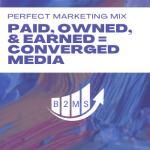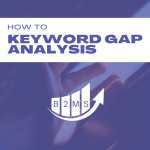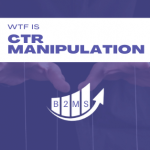Quickly boost conversions with Buying Intent Keywords
Understanding the mindset of someone browsing the internet brings you closer to delivering what they need and accumulating success for yourself.
Familiarizing yourself with customers’ keywords is the best way to decipher their intent and knowing where they stand in the marketing funnel.
In other words, knowing buyer intent keywords helps you provide them with what they’re seeking, as well as organize and plan your operation.

Definition of Buying Intent Keywords
Purchase intent keywords are search terms that indicate whether the customer browsing the topic is likely to buy something or not. Often those phrases include terms like buying or purchasing, as well as comparison terms like best, top, or cheapest.
Examples for the keyword running shoe
- Buy running shoe
- Best running shoe
- Best running shoe for women
- Best rated running shoe
- Cheapest [brand] running shoe
Once you know these words, you can target the specific audience you need for your exact content, product, or service.
In other words, you’ll understand what words to use according to where the audience is in the marketing funnel. Consequently, you’ll master buyer intent marketing.
What Are the Reasons People Run a Search?
The answer might seem easy at face value, but there’s more to it than a simple Google search or other search engines. It’s important to tailor your SEO writing to match the search intent.
There are four levels to why someone could run a query:

1. Informational intent
When someone runs an informational-intended query, they’re looking for a specific answer. In other words, they’re looking for the how, why, what, and tutorials.
Informational keywords sound like this: “How to fix a laptop that keeps rebooting?”
Typically, this kind of search happens when the customer is aware of a problem. However, they don’t know the solution or a specific brand or website to fix their issue.
2. Commercial search intent
The second type of buyer intent keyword is commercial. Commercial intent keywords show that a customer is looking for a solution or check-out.
They want to know the best product, find a review, compare two services, or look for a specific product or service name.
Examples of commercial intent keywords are “Best laptop for gaming” or “iPhone 13 review.”
3. Transactional
Beyond looking for what to do, there’s looking to complete an action. Transactional keywords are high-intent keywords and include terms like “buy,” “for sale,” “online,” “cheap,” “download,” “register,” “quote,” and “sign up.”
For example: “Buy 8 RAM online.” This shows a high purchase intent, where the person lies in the funnels of intent, evaluation, and purchase.
Transactional keywords indicate potential customers and have high purchase or conversion likelihoods.
4. Navigational
Customers use navigational keywords when they’re looking for a certain website or brand. “Facebook login” and “Verizon support,” are considered navigational, as a customer typing those search terms would be looking for a specific product or service.
Not only that, but the customer is in the loyalty part of the buying cycle. Their keyword intent shows that they want a certain brand of communication or a certain brand of running shoes.
Low vs. High Commercial Intent
When it comes to transactional or navigational keywords, it’s a little easier to decipher the keyword intent as well as come up with a buyer intent keywords list.
However, commercial intent is a little trickier. How do you know if the person is merely browsing out of curiosity? And how likely are they to buy something if they like it?
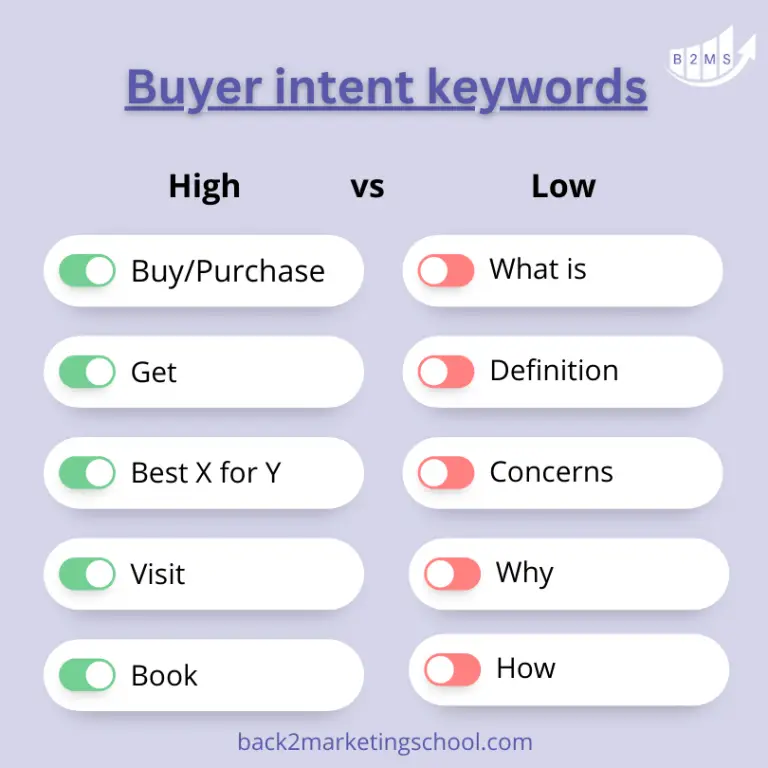
Examples of High Intent: What Are High Buying Intent Keywords?
High buying intent keywords are the surefire indicators that someone is going to make a purchase after browsing.
High-intent keywords are numerous, but there are a couple of well-known pillars. These include:
- Buy
- Get
- Purchase
- Visit
- Book
- Best X for Y, e.g. Best running shoe for newbies
To make the picture clearer, someone that’s looking up “Visit Disneyland” is more likely to book a trip than someone who’s searching for “Is Disneyland fun?”.
What Are Local Keywords?
Local keywords are the ones people use when they’re looking for local products and services. It’s better to use this scope when you want to target conversions from local traffic.
Sometimes, it’s no use getting a lot of traffic from other areas if a product or service can’t be provided except in a certain vicinity.
Examples are:
- Near me
- Best X in [location]
- Service or product in [location]
How to Identify Buyer Intent and Related Purchase Intent Keywords?
The way to find purchase intent keywords is to use free resources, keyword research tools, intent data providers, and proprietary interviews or surveys.
The next important step would be how to identify keyword intent and types of buyer intent keywords.
There are many ways to go about it, so here are your options:
Free resources
You can use several free sources, including a simple Google search, Google Search Console, or Google Keyword Planner.
Keyword Research Tools
When you’re at a more advanced level, you can use professional tools. These include ahrefs, SpyFu, and SEMrush.
Keyword research tools help you crack into the topics, ideas, and patterns of thought that people tap into when they’re looking for different products or services.
Intent Data Providers
A good option would be using intent data providers. These tools help you learn the keywords that show that the buyer needs a little persuasion to press the “Check out” button, as well as the ones that show a buyer is still in the research stage.
In other words, they’re in the “awareness,” “interest,” and “consideration” part of the marketing funnel.
These include Happierleads, Bombora, and Leadfeeder.
Interviews and Surveys
Finally, you can deploy your own sales team to run interviews and surveys to understand the mind of your customers better.
How to Rank for High Competitive Money Keywords
The importance of so-called “money keywords” cannot be underestimated. Some industries and, consequently, search terms are highly competitive. Therefore, extensive planning and optimization of Google Ads and SEO are required. However, it primarily revolves around the relevance between the search intent and your website. This means that you must fully address the search intent in both SEO and pay-per-click advertising. For example, you should not bid on keywords that expect a list as a search result, such as “10 best toys for dogs,” if you only want to sell a single product directly on the product page.
You can only optimize your SEO content to a certain extent through keyword placements and on-page SEO. Additionally, for highly competitive keywords, you will likely need to implement backlinks to gain more authority. Furthermore, you must also be an absolute expert in the entire field and demonstrate thematic authority with a substantial number of articles.
Reporting on High Intent Keywords
Reporting on high-intent keywords is also known as marketing attribution, for which there are various models. These models assign credit for conversions according to the clicks, ads, and other factors that pave the way to conversion.
You can pick one or the other depending on your end goal. For example, you can assign all credits for the conversion of the last or first clicked event (single-touch attribution), or allocate all clicks across the path. For instance, you can pick between a U-shaped, W-shaped, Z-shaped, linear, or time-decay attribution.
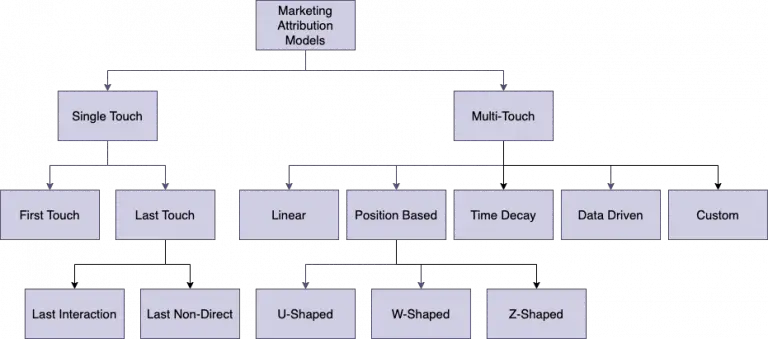
FAQs
Isn’t Search Volume More Important?
While search volume has some importance, it’s a game of probability. For example, if there are 100 informational searches, there’s a probability that up to 90% of them—if not more—won’t be purchasing that same session.
Conversely, if they were commercial, transactional, or navigational, the situation is flipped and a high percentage of visitors are converting. That’s why it’s crucial to find buyer intent keywords.
What Are Good Conversion Rates for High-Intent Keywords?
The CVR depends on what is defined as a conversion. Downloading a whitepaper or registering for a webinar has higher conversion rates than actually checking out a product or scheduling a sales demo. It also varies by the industries.
Overall, a good conversion rate for purchase-behaviors is on average around 2.35%. Among the top 25% performers, the conversion rate becomes 5.31% or higher.
Final Thoughts about Buying Intent Keywords
Once you figure out the main concepts behind buying intent keywords, the whole thing doesn’t seem so complicated.
With good keyword planning and a solid content marketing strategy, you can make conversion rates skyrocket.
Now it’s time to create high converting landing pages. Our favorite tool, to capture more of the high qualified traffic is Unbounce.

Sascha is a Lifecycle Marketing Consultant with over 8 years of digital marketing experiences in Silicon Valley, the UK, and Germany.
After leading the demand generation for a 100+ million company, he decided to venture out on himself. He’s now helping clients to attract and convert more leads and customers.
His main focus are SEO, paid media & marketing automation – all with the focus to tie marketing campaigns to revenue.
Sascha has been featured in industry publications.

